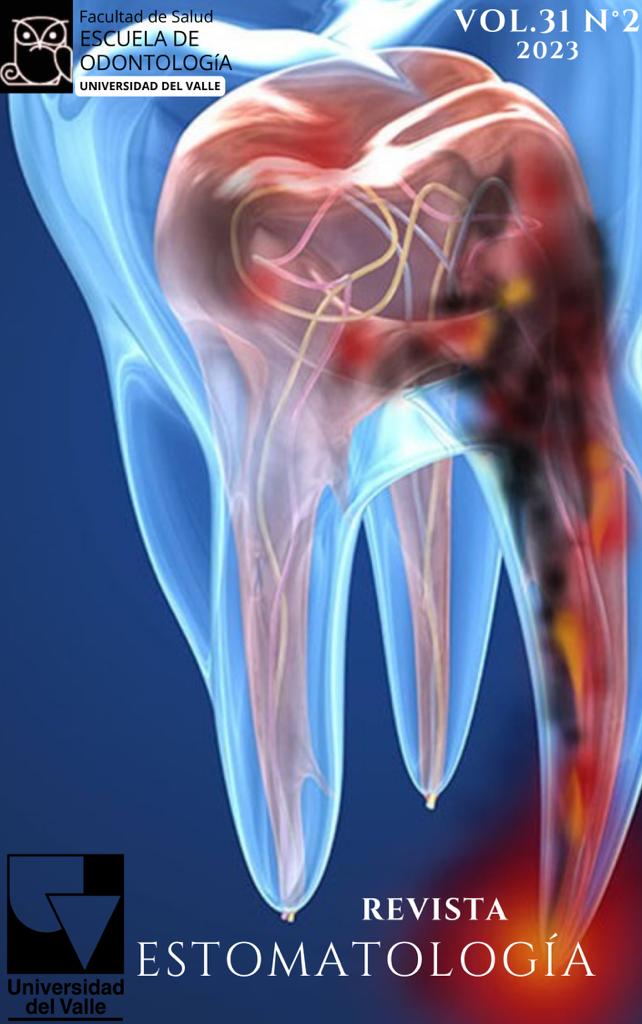Comparative study of 3 methods of crimping in orthodontic hooks with two different types of applied force (elastomeric chains and tie-backs) – in vitro study.
Keywords:
Orthodontic Appliance, In Vitro Techniques, Materials TestingMain Article Content
Introduction: the objective of this study was to compare 3 methods of crimping orthodontic hooks with 2 different types of force using tiebacks or elastomeric chains.
Methods: 100 crimped hooks, 100 dotted hooks and 100 hooks with a V stop bending on the archwire, divided into 6 groups were put to detachment test in a universal machine SHIMADZU 5000 applying force by means of tiebacks and elastomeric chains, for the use of the machine an accessory base and arm was designed to keep the test stable and standardized. Data were analyzed using GraphPad Prims 8 for Windows. Significance was predetermined at a =0.05. The Shapiro–Wilk test was used to test the data for normality. The data were not normally distributed and therefore the Kruskal Wallis test was used to determine differences between groups, followed by Dunn's multiple comparisons test.
Results: The maximum forces obtained for the detachment of an orthodontic hook was up to 2.87kg which was recorded by the group of dotted hooks and with force applied with elastomeric chain and the one with the lowest force was 0.87kg with hooks only crimped. The tie backs showed a more controlled force in all groups and the groups with a “V stop” bend also showed the most stable tests and none displacement of the hook but more eviction and break of the hooks.
Conclusions: In the study it was determined that the crimping method is not sufficient for the stability of the hook so pointing it or performing a V stop bend on the wire increases its stability before the maximum force of detachment and clinically gives advantages in the dental movement although it increases the consultation or laboratory time for its realization.
Stomatologic SII. Worldwide prevalence of malocclusion in the different stages of dentition: a systematic review and meta-analysis. Eur J Paediatr Dent. 2020;21:115.
Afzal E, Fida M, Malik DS, Irfan S, Gul M. Comparison between conventional and piezocision-assisted orthodontics in relieving anterior crowding: a systematic review and meta-analysis. Eur J Orthod. 2021;43(3):360-6.
Carruitero MJ, Castillo AD, Garib D, Janson G. Stability of maxillary interincisor diastema closure after extraction orthodontic treatment. Angle Orthod. 2020;90(5):627-33.
Gaitan-Romero L, Shujaat S, Ma H, Orhan K, Shaheen E, Mulier D, et al. Evaluation of long-term hard tissue relapse following surgical–orthodontic treatment in skeletal class II patients: A systematic review and meta-analysis. Int J Oral Maxillofac Surg. 2021;50(4):477-86.
McLaughlin RP, Bennett JC, Trevisi HJ. Systemized orthodontic treatment mechanics. 2001;
Siatkowski RE. Optimal orthodontic space closure in adult patients. Dent Clin North Am. 1996;40(4):837-73.
Johal A, Loh S, Heng JK. A clinical investigation into the behaviour of crimpable archwire hooks. J Orthod. 2001;28(3):203-6.
Catalfamo L, Gasperoni E, Celli D. Smart distalization of the upper arch with an easy, efficient and no-compliance procedure. J Orthod. 2021;14653125211057566.
Karsten ALA, Forsberg CM, Oberg M. The resistance to axial dislodgement of nickel titanium compression arch wire hooks-an in vitro study. Australas Orthod J. 2019;35(1):21-6.
Evans R, Jones M. Laboratory evaluation of surgical ball hook crimping pliers. Int J Adult Orthodon Orthognath Surg. 1991;6(1):57-60.
O’Bannon SP, Dunn WJ, Lenk JS. Comparison of torsional stability of 2 types of split crimpable surgical hooks with soldered brass surgical hooks. Am J Orthod Dentofacial Orthop. 2006;130(4):471-5.
Johal A, Harper CR, Sherriff M. Properties of crimpable archwire hooks: a laboratory investigation. Eur J Orthod. 1999;21(6):679-83.
Gomes NLEA, Melo PM, Lacerda SR, D’Albuquerque MPJ. Evaluation in vitro of the tensile strength of crimpable hooks used for stabilization in orthognathic surgery. Oral Surg Oral Med Oral Pathol Oral Radiol. 2012;113(3):308-12.
Griffin JT, Ferracane J. Laboratory evaluation of adhesively crimped surgical ball hooks. Int J Adult Orthodon Orthognath Surg. 1998;13(2):169-75.
Oshagh M, Ajami S. A comparison of force decay: elastic chain or tie-back method? World J Orthod. 2010;11(4).
Fatima A, Prasad Konda AF, Shaikh H, Zohra B, Fareeduddin B. A Comparison of Force Decay between Coil Spring, Elastomeric Chain and Tie-backs in Various Alcohol Concentrations found in Mouth Rinse: An In-vitro Study.
Eliades T, Eliades G, Silikas N, Watts D. Tensile properties of orthodontic elastomeric chains. Eur J Orthod. 2004;26(2):157-62.
Yagura D, Baggio PE, Carreiro LS, Takahashi R. Deformation of elastomeric chains related to the amount and time of stretching. Dent Press J Orthod. 2013;18:136-42.
Lai WJ, Midorikawa Y, Kanno Z, Takemura H, Suga K, Soga K, et al. A new orthodontic force system for moment control utilizing the flexibility of common wires: evaluation of the effect of contractile force and hook length. J Formos Med Assoc. 2018;117(1):71-9.
Downloads

This work is licensed under a Creative Commons Attribution-NonCommercial-NoDerivatives 4.0 International License.
Los autores/as conservan los derechos de autor y ceden a la revista el derecho de la primera publicación, con el trabajo registrado con la licencia de atribución de Creative Commons, que permite a terceros utilizar lo publicado siempre que mencionen la autoría del trabajo y a la primera publicación en esta revista.

